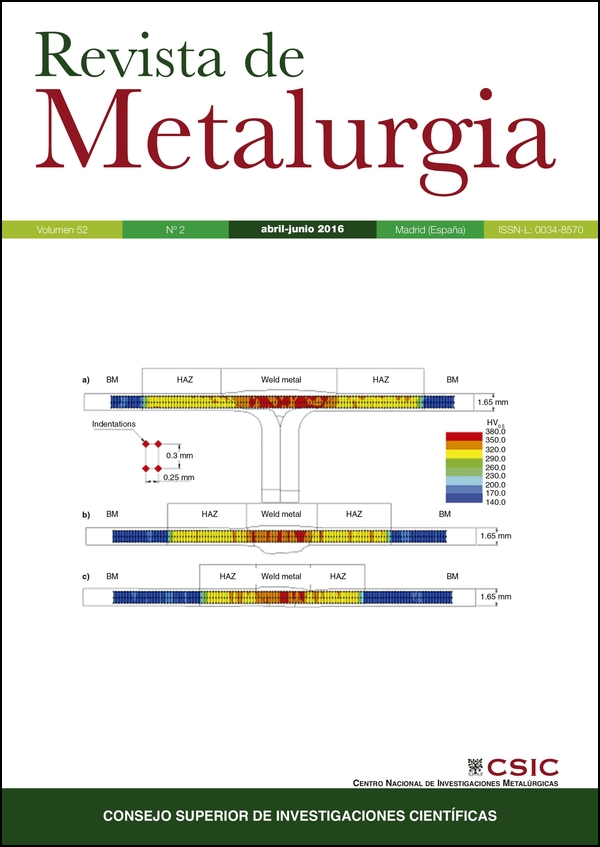Experiment and simulation analysis of roll-bonded Q235 steel plate
DOI:
https://doi.org/10.3989/revmetalm.069Keywords:
Heavy-gauge steel plate, MARC simulation, Roll bondingAbstract
Heavy-gauge Q235 steel plate was roll bonded, and the process was simulated using MARC software. Ultrasonic testing results revealed the presence of cracks and lamination defects in an 80-mm clad steel sheet, especially at the head and tail of the steel plate. There were non-uniform ferrite + pearlite microstructures and unbound areas at a bond interface. Through scanning electron microscopy analysis, long cracks and additional inclusions in the cracks were observed at the interface. A fracture analysis revealed non-uniform inclusions that pervaded the interface. Moreover, MARC simulations demonstrated that there was little equivalent strain at the centre of the slab during the first rolling pass. The equivalent centre increased to 0.5 by the fourth rolling pass. Prior to the final pass, the equivalent strain was not consistent across the thickness direction, preventing bonding interfaces from forming consistent deformation and decreasing the residual stress. The initial rolling reduction rate should not be very small (e.g. 5%) as it is averse to the coordination of rolling deformation. Such rolling processes are averse to the rolling bond.
Downloads
References
Boettinger, W.J., Coriell, S.R., Greer, A.L., Karma, A., Kurz, W., Rappaz, M., Trivedi, R. (2000). Solidification microstructures: recent developments, future directions. Acta Mater. 48 (1), 43–58. http://dx.doi.org/10.1016/S1359-6454(99)00287-6
Ceretti, E., Fratini, L., Gagliardi, F., Giardini, C. (2009). A new approach to study material bonding in extrusion porthole dies. CIRP Ann-Manuf. Techn. 58 (1), 259–262. http://dx.doi.org/10.1016/j.cirp.2009.03.010
Cooper, D.R., Allwood, J.M. (2014). The influence of deformation conditions in solid-state aluminum welding processes on the resulting weld strength. J. Mater. Process. Tech. 214 (11), 2576–2592. http://dx.doi.org/10.1016/j.jmatprotec.2014.04.018
Kim, J.K., Huh, M.Y., Lee, J.C., Jee, K.K., Engler, O. (2004). Evolution of strain states and textures during roll-cladding in STS/A1/STS sheets. J. Mater. Sci. 39 (16), 5371–5374. http://dx.doi.org/10.1023/B:JMSC.0000039247.10346.5d
Li, W.B., Yuan, S.Y., Li, G.L., Wang, C.S., Feng, J. (2015). Microstructure and mechanical properties of low alloy clad heavy steel plate. Heat Treat. Met. 40 (6), 49–53.
Liu, J.Y. (2010). Research on deformation rules of heavy gauge steel plate clad rolling. Northeastern University 27, 50–54.
Luo, Z.A., Xie, G.M., Hu, Z.H., Jia, T., Wang, G.D., Wang, L.J. (2009). Experiment study of rolling technology on heavy gauge compound plates. Journal of Plasticity Engineering 16 (4), 125–128.
Nishida, S., Matsuoka, T., Wada, T. (2005). Technology and Products of JFE Steel's Three Plate Mills. JFE Technical Report 5, 1–9. http://www.jfe-steel.co.jp/en/research/report/005/pdf/005-02.pdf.
Nishimura, K., Takeuchi, Y. (2014). Mechanical Properties Distribution through the Thickness of Heavy Gauge Steel Plate Rolled in Intercritical Region. Tetsu to Hagane 100 (9), 1097–1103. http://dx.doi.org/10.2355/tetsutohagane.100.1097
Shen, J., Li, H., Wang, Y. (2011). Discussion on rolling and processing of extra heavy steel plate with large single piece weight in China. Wide and Heavy Plate 17 (2), 23–26.
Takashi, F., Yasunobu, J. (2003). Rolling technology of composite steel. Plastic and Processing, 44 (512), 14–19.
Yu, W., Zhang, Y.M., He, C.Y., Xu, L.S., Cai, Q.W. (2011). Production of heavy-gauge steel plates by clad rolling process. J. Univ. Sci. Technol. Beijing 33 (11), 1391–1395.
Zang, Y., Cao, J.N., Hu, X.Z. (2009). The analyzed for the processing way to product heavy plate by ingot. CSM Annual Meeting Proceedings, pp. 268–273.
Zhang, S.H., Liu, J.S. (2015). Advanced technology and materials processing MSC. Marc realization, National Defence Industry Press, China, pp. 31–38.
Published
How to Cite
Issue
Section
License
Copyright (c) 2016 Consejo Superior de Investigaciones Científicas (CSIC)

This work is licensed under a Creative Commons Attribution 4.0 International License.
© CSIC. Manuscripts published in both the printed and online versions of this Journal are the property of Consejo Superior de Investigaciones Científicas, and quoting this source is a requirement for any partial or full reproduction.
All contents of this electronic edition, except where otherwise noted, are distributed under a “Creative Commons Attribution 4.0 International” (CC BY 4.0) License. You may read the basic information and the legal text of the license. The indication of the CC BY 4.0 License must be expressly stated in this way when necessary.
Self-archiving in repositories, personal webpages or similar, of any version other than the published by the Editor, is not allowed.
















